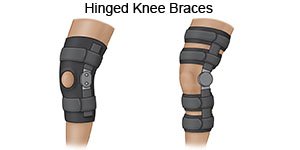PT for ACL Injury
Medically reviewed by Drugs.com. Last updated on Sep 23, 2025.
AMBULATORY CARE:
Physical therapy (PT)
can help you build strength and increase range of motion (ROM) after an ACL injury. Strong muscles help protect your knee. PT can also help you learn to do your daily activities safely while you recover. You may swim or ride a stationary bicycle as part of your therapy. PT is used both before and after surgery. Your healthcare provider may want you to do PT even if you are not having surgery.
Before surgery,
the goal is to increase your ROM, build strength in your quadriceps, and control swelling. It is important to go to PT even if you are going to have surgery. You may have pain or discomfort that prevents you from wanting to work your leg. The exercises should get more comfortable as you continue.
During the first 2 to 4 weeks after surgery,
the goals are full knee extension and weight bearing. You will focus on more ROM exercises. PT will begin immediately after surgery. You will need to use crutches for a time after surgery. The amount of weight you can put on your leg will depend on the type of surgery you had. Your PT provider can show you how to exercise safely during this time. You may also have a brace to use after surgery. Your provider can show you how to use the brace.
 |
From 4 to 12 weeks after surgery,
the goals are for you to gain even more ROM and to walk normally. You will also focus on building strength in your quadriceps and hamstrings. Your PT provider will show you exercises to help build muscle strength.
Starting 3 months after surgery,
the goal is for you to become able to be able to run again. You will work on gaining speed and increasing the amount of time you can run. Your PT provider may give you specific drills (exercises) related to sports you play. Your provider can help you plan to start playing sports again. You will need to have strength and stability, and no longer have pain.
Safety precautions:
- Warm up before you do knee exercises. Walk or ride a stationary bike for 5 or 10 minutes to warm your muscles.
- Follow your PT provider's directions for activity. You will not be able to run or play sports right away. PT takes time. You will need to build your speed and endurance. Do not try to lift heavy weights or do weight-bearing activities before your provider says you are ready. You may cause more injury to your ACL.
- Stop if you feel pain. Pain may be a sign that you are not ready to be doing a certain movement. You should expect some discomfort at first. Your leg may be stiff or sore. As you continue PT, it should become easier to do the exercises without discomfort. Always tell your provider if a movement causes pain.
© Copyright Merative 2025 Information is for End User's use only and may not be sold, redistributed or otherwise used for commercial purposes.
The above information is an educational aid only. It is not intended as medical advice for individual conditions or treatments. Talk to your doctor, nurse or pharmacist before following any medical regimen to see if it is safe and effective for you.
Further information
Always consult your healthcare provider to ensure the information displayed on this page applies to your personal circumstances.
